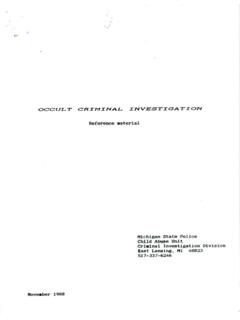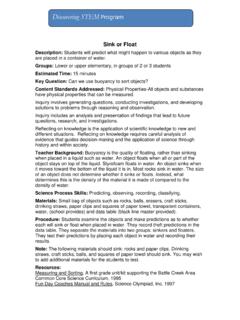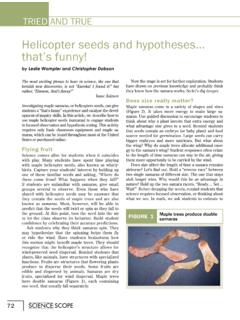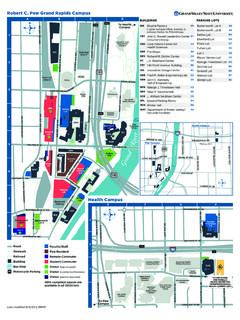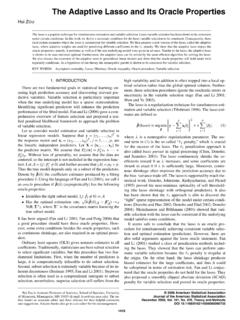Transcription of Behavioral Study of Obedience - Grand Valley State …
1 Behavioral Study of ObedienceStanley Milgram(1963)This article describes a procedure for the Study of destruc-tive Obedience in the laboratory. It consists of orderinga naiveSto administer increasingly more severe punish-ment to a victim in the context of a learning is administered by means of a shock genera-tor with 30 graded switches ranging fromSlight ShocktoDanger: Severe Shock. The victim is a confederate of theE. The primary dependent variable is the maximum shocktheSis willing to administer before he refuses to continuefurther. 26Ss obeyed the experimental commands fully,and administered the highest shock on the generator. 14Ss broke off the experiment at some point after the victimprotested and refused to provide further answers.
2 The pro-cedure created extreme levels of nervous tension in someSs. Profuse sweating, trembling, and stuttering were typ-ical expressions of this emotional disturbance. One unex-pected sign of tension yet to be explained was theregular occurrence of nervous laughter, which in someSsdeveloped into uncontrollable seizures. The variety of in-teresting Behavioral dynamics observed in the experiment,the reality of the situation for theS, and the possibility ofparametric variation within the framework of the proce-dure, point to the fruitfulness of further is as basic an element in thestructure of social life as one can point system of authority is a requirement of allcommunal living, and it is only the man dwellingin isolation who is not forced to respond, throughdefiance or submission, to the commands of oth-ers.
3 Obedience , as a determinant of behavior, is ofparticular relevance to our time. It has been reli-ably established that from 1933 45 millions of in-nocent persons were systematically slaughtered oncommand. Gas chambers were built, death campswere guarded; daily quotas of corpses were pro-duced with the same efficiency as the manufactureof appliances. These inhumane policies may haveoriginated in the mind of a single person, but theycould only be carried out on a massive scale if avery large number of persons obeyed is the psychological mechanism thatlinks individual action to political purpose. It is thedispositional cement that binds men to systems ofauthority. Facts of recent history and observationin daily life suggest that for many persons obedi-ence may be a deeply ingrained behavior tendency,indeed a prepotent impulse overriding training inethics, sympathy, and moral conduct.
4 C. P. Snow(1961) points to its importance when he writes:When you think of the long and gloomy history ofman, you will find more hideous crimes have beencommitted in the name of Obedience than have everbeen committed in the name of rebellion. If youdoubt that, read William Shirer sRise and Fall ofthe Third Reich. The German Officer Corps werebrought up in the most rigorous code of Obedience .. in the name of Obedience they were party to, andassisted in, the most wicked large scale actions in thehistory of the world [p. 24].While the particular form of Obedience dealtwith in the present Study has its antecedents in theseepisodes, it must not be thought all Obedience en-tails acts of aggression against others.
5 Obedienceserves numerous productive functions. Indeed, thevery life of society is predicated on its may be ennobling and educative and re-fer to acts of charity and kindness as well as to ProcedureA procedure was devised which seems useful as atool for studying Obedience (Milgram, 1961). Itconsists of ordering a naive subject to administerelectric shock to a victim. A simulated shock gen-1 Milgram, S. (1963). Behavioral Study of of Abnormal and Social Psychology, 67, 371 Study of Obedienceerator is used, with 30 clearly marked voltage lev-els that range from 15 to 450 volts. The instrumentbears verbal designations that range fromSlightShocktoDanger: Severe Shock.
6 The responses ofthe victim, who is a trained confederate of the exper-imenter, are standardized. The orders to administershocks are given to the naive subject in the contextof a learning experiment ostensibly set up to studythe effects of punishment on memory. As the ex-periment proceeds the naive subject is commandedto administer increasingly more intense shocks tothe victim, even to the point of reaching the levelmarkedDanger: Severe Shock. Internal resistancesbecome stronger, and at a certain point the subjectrefuses to go on with the experiment. Behavior priorto this rupture is considered Obedience , in that thesubject complies with the commands of the exper-imenter. The point of rupture is the act of disobe-dience.
7 A quantitative value is assigned to the sub-ject s performance based on the maximum intensityshock he is willing to administer before he refusesto participate further. Thus for any particular sub-ject and for any particular experimental conditionthe degree of Obedience may be specified with a nu-merical value. The crux of the Study is to systemat-ically vary the factors believed to alter the degree ofobedience to the experimental technique allows important variables to bemanipulated at several points in the may vary aspects of the source of command,content and form of command, instrumentalities forits execution, target object, general social setting,etc. The problem, therefore, is not one of design-ing increasingly more numerous experimental con-ditions, but of selecting those that best illuminatetheprocessof Obedience from the sociopsychologi-cal of Age and Occupational Types in the ExperimentAges% of TotalOccupations20 2930 3940 50(occupations)Workers, , (Age)204040 Related StudiesThe inquiry bears an important relation to philo-sophic analyses of Obedience and authority (Arendt,1958; Friedrich, 1958; Weber, 1947), an early ex-perimental Study of Obedience by Frank (1944),studies in authoritarianism (Adorno, Frenkel-Brunswik, Levinson, & Sanford, 1950.)
8 Rokeach,1961), and a recent series of analytic and empiricalstudies in social power (Cartwright, 1959). It owesmuch to the long concern withsuggestionin socialpsychology, both in its normal forms ( , Binet,1900) and in its clinical manifestations (Charcot,1881). But it derives, in the first instance, from di-rect observation of a social fact; the individual whois commanded by a legitimate authority ordinarilyobeys. Obedience comes easily and often. It is aubiquitous and indispensable feature of social subjects were 40 males between the ages of20 and 50, drawn from New Haven and the sur-rounding communities. Subjects were obtained bya newspaper advertisement and direct mail solic-itation.
9 Those who responded to the appeal be-lieved they were to participate in a Study of mem-ory and learning at Yale University. A wide rangeof occupations is represented in the sample. Typi-cal subjects were postal clerks, high school teach-ers, salesmen, engineers, and laborers. Subjectsranged in educational level from one who had notfinished elementary school, to those who had doc-torate and other professional degrees. They werepaid $ for their participation in the Study of ObedienceHowever, subjects were told that payment was sim-ply for coming to the laboratory, and that the moneywas theirs no matter what happened after they ar-rived. Table 1 shows the proportion of age and oc-cupational types assigned to the experimental and LocaleThe experiment was conducted on the grounds ofYale University in the elegant interaction labora-tory.
10 (This detail is relevant to the perceived le-gitimacy of the experiment. In further variations,the experiment was dissociated from the univer-sity, with consequences for performance.) The roleof experimenter was played by a 31-year-old highschool teacher of biology. His manner was impas-sive, and his appearance somewhat stern throughoutthe experiment. He was dressed in a gray techni-cian s coat. The victim was played by a 47-year-old accountant, trained for the role; he was of Irish-American stock, whom most observers found mild-mannered and naive subject and one victim (an accomplice)performed in each experiment. A pretext had tobe devised that would justify the administration ofelectric shock by the naive subject.

